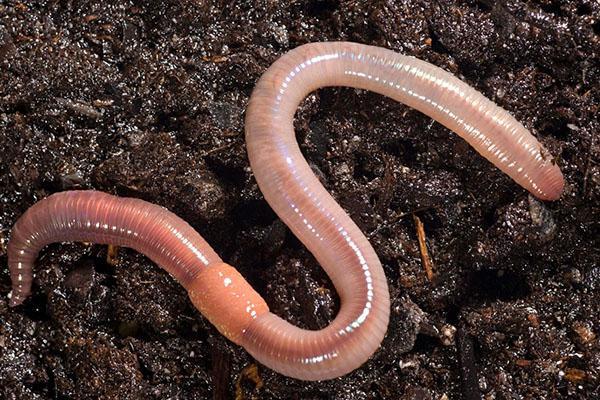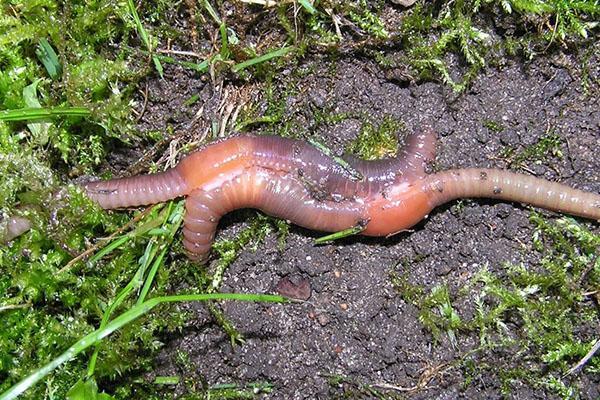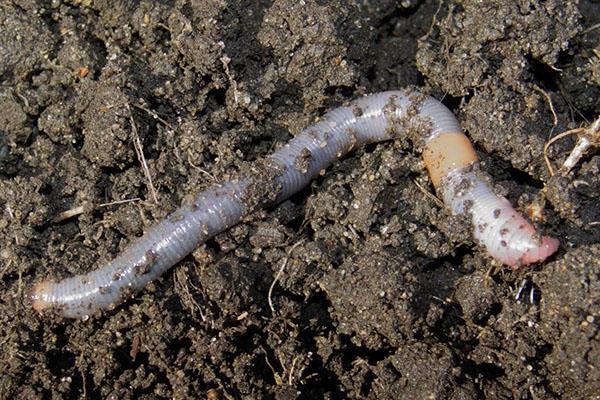What are earthworms for on the site and how to breed them
 Earthworms in the garden or in the garden are the most desirable inhabitants. They bring many benefits to the soil, loosening and enriching it. Therefore, it is so important to know whether earthworms are useful, the peculiarities of their life and methods of breeding at their summer cottage.
Earthworms in the garden or in the garden are the most desirable inhabitants. They bring many benefits to the soil, loosening and enriching it. Therefore, it is so important to know whether earthworms are useful, the peculiarities of their life and methods of breeding at their summer cottage.
Life cycle of an earthworm

After fertilization of the egg, the worm sheds a cocoon over its head. A worm develops in this shell, which emerges from it as a fully formed individual. Most often, only one earthworm is born from one egg. This happens 2-3 weeks after fertilization, and after 3 months the babies grow to the size of an adult. Newly hatched worms reach a length of 1-1.5 cm, they immediately begin to look for food and eat it. The average life span of these animals is 5 to 7 years. What makes the earthworm a long-liver among their own kind.
Why is earthworm useful?
 It is impossible to overestimate the significance of these earth-dwelling creatures. Considering how useful worms are, first of all, it is worth noting that their presence in the soil is the first sign of its fertility.
It is impossible to overestimate the significance of these earth-dwelling creatures. Considering how useful worms are, first of all, it is worth noting that their presence in the soil is the first sign of its fertility.
Earthworms perform many important functions:
- In search of food, they make tunnels in the ground, which significantly loosen it up, promote the penetration of air and water into the soil.
- They eat organic residues, parts of plants rot faster.
- Enriched with humus. This is the main soil benefit of earthworms.
- Promotes the increase in potassium and phosphorus in the soil.
- The soil is mixed with plant residues, and evenly, in the form of small particles, they significantly increase the fertility of the soil.
- Along the passages dug by worms, the roots of plants move more easily, constantly finding nutrient reserves in them.
- In addition, considering how earthworms serve the soil, it is worth noting that large stones, due to the movement of soil layers, gradually descend to the depth, and small particles grind into dust in the intestines of earthworms.
- Colonies of beneficial bacteria and fungi settle on the walls of the passages dug by these animals.
Digging through passages, earthworms swallow the earth. One adult per day passes through itself up to 5 g of earth, which is equal to its weight.
With the help of these hard workers, any organic residues can be turned into vermicompost - fertilizer for vegetable gardens and flower beds. That is why earthworms are so actively bred in the world on special farms.
In addition to being important for the soil, earthworms are the main food source for birds in early spring. This is a kind of bait for them in the gardens. With warming, they turn their attention to insect pests... Anglers also breed worms specially to use them as bait for fish.
Earthworms: a way of feeding
 An earthworm can be safely called an omnivorous creature. He is able to consume huge amounts of food.Often, earthworms drag food underground, and then eat it or store it in special burrows. There they fold the leaves, compacting them and smearing the gaps between them with earth from their intestines.
An earthworm can be safely called an omnivorous creature. He is able to consume huge amounts of food.Often, earthworms drag food underground, and then eat it or store it in special burrows. There they fold the leaves, compacting them and smearing the gaps between them with earth from their intestines.
These animals are nocturnal. The way the earthworm feeds is very peculiar. Escaping to the surface of the soil in the dark, he tears off a small piece of food, holding it between the prominent upper and lower lip. Meanwhile, the powerful pharynx protrudes forward, creating a fulcrum for the upper lip. Food is first ground in the pharynx, and then enters the intestines, where it is exposed to special enzymes. Part of the nutrients is absorbed and provides the body with the necessary energy, while the rest of the components are released together with the earth and enrich the soil.
The famous scientist Charles Darwin devoted a lot of time to the study of the life of earthworms. In his work, he described how these animals ate the meat they had previously left. In addition, they even ate pieces of their dead brethren. For which the scientist called cannibals.
Eating worms in nature
 Many are interested in what do earthworms eat in nature? Under natural conditions, these animals consume mainly plant foods, therefore, it is not recommended to feed them with animal protein during artificial breeding.
Many are interested in what do earthworms eat in nature? Under natural conditions, these animals consume mainly plant foods, therefore, it is not recommended to feed them with animal protein during artificial breeding.
Earthworm's favorite food:
- fresh leaves, except for very hard veins;
- fallen leaves, which they actively store in burrows;
- rotten parts of the stems;
- fallen flowers.
They settle in soil that is rich humus... They eat the foliage by biting off small pieces.
How to breed worms in the garden
 These animals are found everywhere. Depending on the species, they inhabit soil layers at a depth of 10 cm to 1 meter. Since it is not difficult to breed worms in the garden, they are often grown in personal plots.
These animals are found everywhere. Depending on the species, they inhabit soil layers at a depth of 10 cm to 1 meter. Since it is not difficult to breed worms in the garden, they are often grown in personal plots.
In order for the worms to settle in the required territory, you need:
- Dig a small hole in the ground, about 30-40 cm sides.
- Place foliage, waste paper, old newspapers at the bottom. Drizzle abundantly with water or some kind of slop with organic residues.
- After about a week, some worms should be placed on the prepared surface, collected in a damp place (under foliage, stones).
- A few days later, "pets" begin to feed. Any organic matter is suitable for these purposes: animal manure, poultry litter, food waste, skins of vegetables and fruits, wet paper, bread crumbs, drunk tea or ground coffee. Top dressing is carried out at least 1 time in 2 weeks, each time covering the nursery with a 5 cm layer of food.
- The soil is regularly moistened. It is better to use settled water or rainwater, pouring it on the nursery from a watering can. The optimum humidity for keeping earthworms is 80%.
- Twice a week, the compost heap is gently loosened to enrich it with oxygen.
Worms can be bred in special boxes in any technical premises (basements, sheds). They are not kept in residential premises due to their specific smell. The contents of the box turn into vermicompost in a few months. The easiest way to extract the worms is to spread the bait on the surface. For example, paper soaked in sweet water. The collected worms are populated into a new portion of compost.
When breeding worms, you should protect them from moles, which are their main enemies in their summer cottage.
Where and how earthworms winter
 With the onset of cold weather, these animals sink into deeper layers of the soil, which do not freeze. Earthworms hibernate in special rookeries, lined with foliage, feathers, and wool. The exit is closed with an earthen plug. There they practically go into hibernation. With the onset of spring, the earth warms up, the animals feel the change in temperature and again go to the soil surface, which is especially wet at this time.
With the onset of cold weather, these animals sink into deeper layers of the soil, which do not freeze. Earthworms hibernate in special rookeries, lined with foliage, feathers, and wool. The exit is closed with an earthen plug. There they practically go into hibernation. With the onset of spring, the earth warms up, the animals feel the change in temperature and again go to the soil surface, which is especially wet at this time.
With artificial breeding, the nursery is not watered in cold weather, and with the first frosts, the place where earthworms winter is insulated by covering it with a layer of manure and straw (about 50 cm).
Earthworms are considered one of the most ancient inhabitants of our planet. For millions of years, they have made the land more fertile, contributing to the emergence of abundant vegetation.